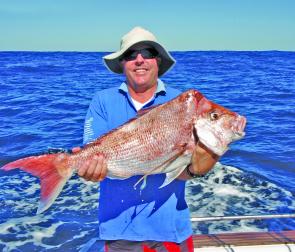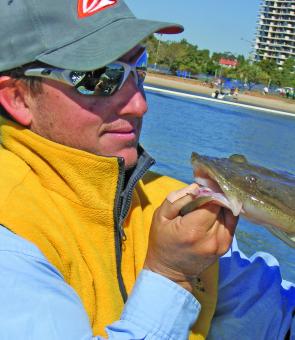As the year rolls around to July, the days will get even shorter and a whole new host of species will be on offer.
July is a prime snapper month, and they are available using a number of different methods.
Soft plastics for snapper is a growing epidemic in the area and those that have tried it will understand why. When using softies for snapper I find most of my bites occur as the lure is descending, and they tend to be a better class of fish. I use the lightest jighead possible so that I maximise the sink time.
When selecting the jighead you need to also consider current and water depth; you may find yourself using anything from 1/4oz to 1 1/2oz – don’t be afraid to experiment. I use a thread line outfit of a about 20-30lb and braided line is a must. As far as type of soft plastic goes, I’m a fan of jerk shad style plastics as I find they are less effected by strong current. Guzzler, Bass Assassins and Gulps are all favourites of mine and colours are not that crucial.
If soft plastics are not really your thing, a big knobby snapper will rarely pass up a well presented bait. By letting your bait slowly waft down with a small sinker you will be able to target the better quality fish that sit higher off of the bottom. This time of year the 18 and 24 fathom reefs east of surfers paradise, as well as Fidos and the Mud Hole, will all produce the goods.
There will also be a range of other reef species around a little bit wider off the coast. The 36 and 42 fathom reefs will hold good numbers of pearl perch, parrotfish, pigfish and a variety of others. I find when targeting reefies it’s pretty hard to beat a paternoster rig, as these fish live hard on the bottom. As far as bait type goes anything fresh is best – pillies, squid and flesh baits will all get good results.
Cobia will start to show up more throughout July. These fish are great fighting and great table fair. You will find them more prevalent on the closer reefs such as the 18 and 24 as well as the Nine Mile and Palm Beach Reef. Cobia are quite partial to a soft plastic but big live bait is preferred by most. Live baits such as tailor, snapper, slimies or yakkas are fine and anything up to about a kilo is more than edible to a passing cobia. I like fishing an 8oz barrel sinker fixed between two swivels then run to one or two (depending on bait size) 9/0 hooks, with a trace of around 80lb. A lighter trace of around 30-50lb line is fine for cobia but a big one will give you plenty of curry, so beware of obstructions such as anchor ropes during a long fight.
The flathead season will really start to kick off in July. These fish are one of the most popular sport and table fish on the east coast so why not give them a go while they are around.
Flathead are found almost everywhere wet, but if you want to target them successfully there are a few things to keep in mind. Flathead are very tide dependant, therefore each spot works on different stages of the tide. At a low tide try the gutters around Crab Island and behind SeaWorld; for a higher tide, the fish will generally be more spread out on the top of the weed banks in most of the estuaries, particularly the southern bank at the entrance of Tallebudgera and the mouth of the Tweed.
Flatties will eat most lures, trolled and cast. For trolling you have to have a few Lively Lure Micro Mullets, these are no doubt the best flathead trolling lure hands down! Other good ones to try are locally made pig lures and Ecogear SX48 and SX60.
Soft plastics are generally the most effective way to catch flathead, anything from 3-6” will catch flathead in most applications. One of my new favourites that I have had great success so far this season is an Ecogear 5” Paramax. This is a curl-tailed plastic and if you use this plastic you will no doubt catch a swag of fish. As usual with soft plastics the size of your jighead can be dictated by several things: water depth, tidal flow and wind strength are all contributing factors. I generally use 1/4oz and 3/8oz for most of my flathead fishing and I think they are the most versatile.
There will be plenty of tailor showing up at the river mouths, most headlands and surf beaches on the start of the run-in tide. Tailor are often ravenous but can be quite fickle from time to time, however, if using metal slug style lures you will rarely miss out on a feed. An important tip is to match the size of your lure to the size of the bait that the fish are feeding on, this can sometimes take a bit of experimenting on each given day but for most efforts anything from 20- 40g is fine.
Sea bream will no doubt also be on offer and are widely targeted. If you’re chasing a quick feed, a running ball sinker to a metre long trace and a size 2 hook is the most effective rig. Yabbies, soldier crab and white pilchards are all top bait performers.
Reads: 2238
July is prime snapper month and they are available using a number of different methods.

Flathead season will really start to kick off in July on the Gold Coast.




